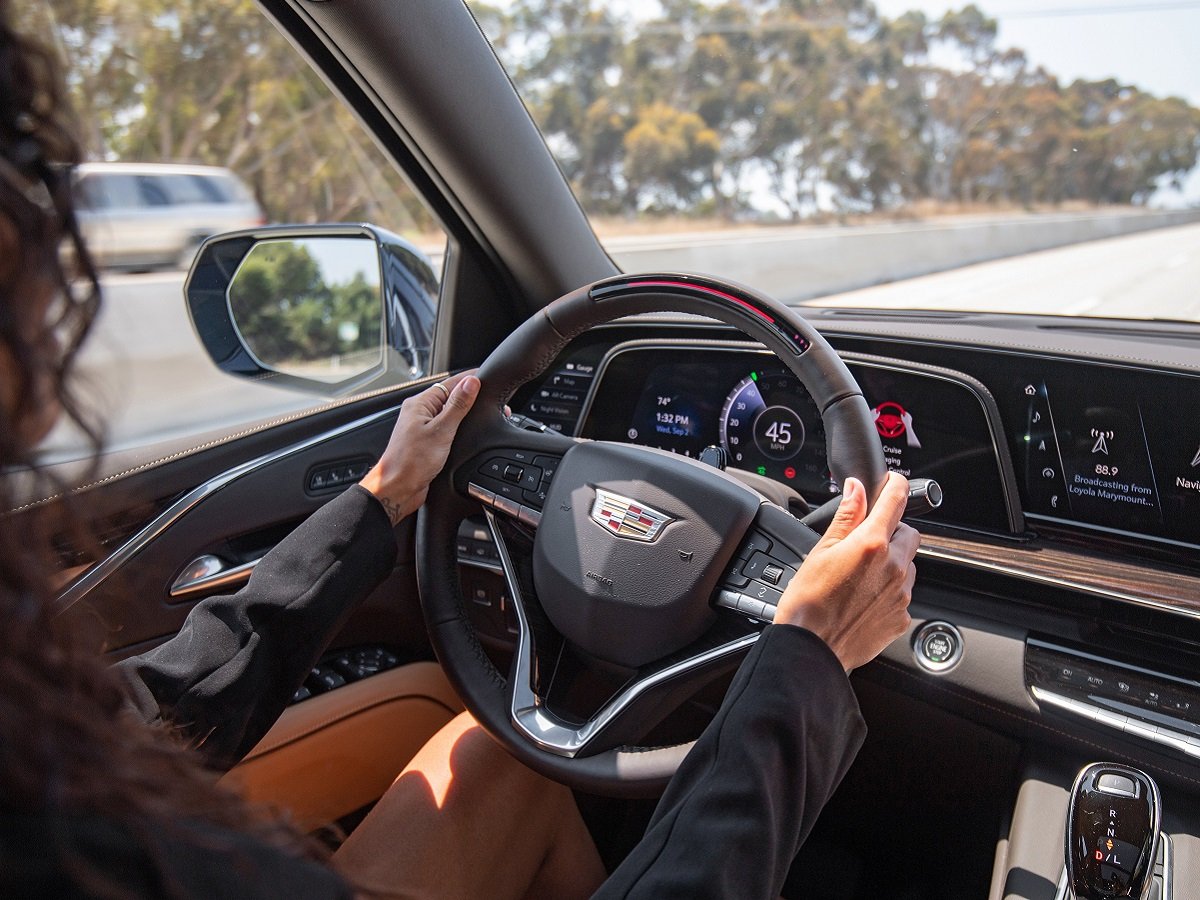Home>Production & Technology>Noise Cancellation>What Is The Dodge Active Noise Cancellation Ram 1500


Noise Cancellation
What Is The Dodge Active Noise Cancellation Ram 1500
Modified: January 26, 2024
Discover how the Dodge Active Noise Cancellation enhances the driving experience of the Ram 1500, reducing unwanted noise for a quieter and smoother ride.
(Many of the links in this article redirect to a specific reviewed product. Your purchase of these products through affiliate links helps to generate commission for AudioLover.com, at no extra cost. Learn more)
Table of Contents
Introduction
As technology continues to evolve, so does the functionality and comfort of vehicles. One significant advancement in the automotive industry is active noise cancellation, which plays a crucial role in enhancing the overall driving experience. In particular, the Dodge Ram 1500 incorporates the innovative Active Noise Cancellation (ANC) system to ensure a quiet and serene cabin environment.
Active Noise Cancellation technology utilizes advanced algorithms and strategically placed microphones and speakers to neutralize unwanted noise and vibrations inside the vehicle. This technology goes beyond traditional passive noise cancellation methods, such as insulation and soundproofing, to actively counteract external sounds.
In this article, we will delve into the world of active noise cancellation, explore the reasons why it is necessary in vehicles, and specifically discuss the Active Noise Cancellation system in the Dodge Ram 1500. We will also highlight the benefits of this technology and compare it with passive noise cancellation systems.
So, if you’re curious about how active noise cancellation can transform your driving experience and improve the comfort of your vehicle, read on to discover the ins and outs of the Dodge Ram 1500’s Active Noise Cancellation system.
What is Active Noise Cancellation?
Active Noise Cancellation, also known as ANC, is a technology designed to reduce or eliminate unwanted noise in various environments, including vehicles. It works by using microphones to detect incoming sounds and then generating sound waves that are precisely out of phase with the detected noise. When these out-of-phase sound waves combine with the original noise, they effectively cancel each other out, resulting in a quieter and more peaceful environment.
The active noise cancellation process involves three key components: microphones, a digital signal processor (DSP), and speakers. The microphones capture the ambient noise from inside the vehicle, while the DSP analyzes and processes the captured sound signals. Based on the analysis, the DSP generates anti-noise signals that are fed to the speakers, which emit the anti-noise waves that counteract the original noise.
This technology is particularly effective in reducing low-frequency noises, such as engine rumble, wind noise, and road vibrations, which are common sources of discomfort and fatigue during travel. By actively canceling out these noises, active noise cancellation enhances the overall driving experience by providing a peaceful and undisturbed environment for both the driver and passengers.
Active noise cancellation is not only limited to vehicles; it is also widely used in other areas, such as noise-canceling headphones, home audio systems, and commercial buildings. However, in the context of vehicles, active noise cancellation has become increasingly important as automakers strive to create a more refined, comfortable, and enjoyable ride for their customers.
The Dodge Ram 1500 has embraced this technology, incorporating an advanced Active Noise Cancellation system to ensure a serene cabin environment. In the next section, we will explore the reasons why noise cancellation is crucial in vehicles and why the Ram 1500 has implemented this feature.
The Need for Noise Cancellation in Vehicles
Noise pollution is a common issue in vehicles and can have a significant impact on the overall driving experience. Excessive noise in the cabin not only causes discomfort and fatigue but also affects the driver’s concentration and ability to hear important auditory cues, such as sirens or other vehicles. This is where noise cancellation technology becomes paramount.
One of the primary reasons for implementing noise cancellation in vehicles is to create a peaceful and enjoyable driving environment. By effectively reducing or eliminating external noises, such as engine noise, wind noise, and tire noise, noise cancellation enhances the overall comfort and tranquility of the cabin. This is particularly beneficial during long trips or when driving in noisy urban environments.
In addition to passenger comfort, noise cancellation also plays a vital role in improving driver concentration and safety. External noises can be distracting and can interfere with the driver’s ability to focus on the road and other important auditory cues. With noise cancellation technology, these distractions are minimized, allowing the driver to maintain better focus and safely navigate through traffic.
Moreover, noise cancellation technology can have a positive impact on the vehicle’s fuel efficiency. By reducing the aerodynamic noise caused by wind resistance, vehicles with noise cancellation systems can experience improved aerodynamics and, consequently, better fuel economy. This benefit not only contributes to cost savings for the driver but also promotes environmental sustainability.
Another reason for the need for noise cancellation in vehicles is the increased demand for more refined and luxurious driving experiences. As people spend more time in their vehicles, whether commuting or traveling, the desire for a quiet and serene cabin environment becomes increasingly important. Noise cancellation technology helps automakers meet this demand, delivering a premium driving experience that rivals that of high-end luxury vehicles.
Ultimately, noise cancellation in vehicles is not just about minimizing outside noise; it is about optimizing the overall driving experience. By creating a quiet and peaceful environment, noise cancellation enhances passenger comfort, driver concentration, safety, fuel efficiency, and the overall enjoyment of the journey.
Next, let’s delve into how the Active Noise Cancellation system works specifically in the Dodge Ram 1500 and the benefits it provides.
How Does Active Noise Cancellation Work in the Dodge Ram 1500?
The Dodge Ram 1500 incorporates an advanced Active Noise Cancellation (ANC) system that is specifically designed to provide a peaceful and quiet cabin environment. This technology utilizes sophisticated algorithms and strategically placed microphones and speakers to actively counteract external noises and vibrations.
The ANC system in the Ram 1500 consists of three main components: microphones, a digital signal processor (DSP), and speakers. The microphones are strategically positioned throughout the vehicle, including the headliner, doors, and pillars, to detect and capture the ambient noise inside the cabin.
Once the microphones capture the noise, the signal is sent to the DSP, which processes and analyzes the sound signals. The DSP uses advanced algorithms to distinguish between desired sounds, such as music or conversations, and unwanted external noise, such as engine rumble or road vibrations.
Based on this analysis, the DSP generates anti-noise signals that are precisely out of phase with the detected noise. These anti-noise signals are then sent to the speakers strategically placed throughout the cabin, including in the headrests.
When the speakers emit the anti-noise waves, they effectively cancel out the original noise, resulting in a quieter and more serene cabin environment. The ANC system continuously monitors the ambient noise and adjusts the anti-noise signals accordingly to maintain optimal noise cancellation performance.
One of the unique features of the ANC system in the Ram 1500 is its ability to adapt to different driving conditions. For example, when the vehicle is in a low-speed urban setting, the system focuses on reducing the noise from the engine and external traffic. On the other hand, during highway driving, the system prioritizes reducing wind noise and road vibrations.
In addition to its noise cancellation capabilities, the ANC system in the Ram 1500 also enhances the audio experience. By reducing external noise, the system improves the clarity and quality of the audio coming from the vehicle’s speakers, allowing passengers to enjoy their music or conversations without interference.
The ANC system in the Dodge Ram 1500 is a testament to the brand’s commitment to providing a refined and comfortable driving experience. By actively canceling out external noise and vibrations, the Ram 1500 ensures that drivers and passengers can fully enjoy their journey in a serene and tranquil cabin environment.
Next, let’s explore the benefits of active noise cancellation in the Ram 1500 compared to passive noise cancellation systems.
Benefits of Active Noise Cancellation in the Ram 1500
The inclusion of active noise cancellation in the Dodge Ram 1500 offers several significant benefits that greatly enhance the driving experience and overall comfort for both the driver and passengers.
1. Reduced Noise Levels: The primary benefit of active noise cancellation is the significant reduction of external noise inside the cabin. Unwanted noises like engine rumble, wind noise, and road vibrations are actively countered, creating a quiet and peaceful environment for all occupants. This reduction in noise levels promotes a more enjoyable and relaxing driving experience, especially during long journeys or in noisy urban settings.
2. Enhanced Comfort: By minimizing external noise, active noise cancellation in the Ram 1500 improves overall passenger comfort. The cabin becomes a serene oasis where conversations can be held at normal levels without the need to raise voices. Additionally, reduced noise levels contribute to reduced fatigue, allowing occupants to arrive at their destination feeling more refreshed and less stressed.
3. Improved Audio Experience: The ANC system in the Ram 1500 not only cancels out external noise but also enhances the audio experience. By reducing background noise, music and audio from the vehicle’s speakers can be enjoyed with greater clarity and detail. This allows occupants to fully immerse themselves in their favorite tunes or have clear conversations without any disturbances.
4. Increased Safety: Active noise cancellation also plays a role in improving driver safety. By reducing external distractions caused by noise, drivers can better focus on the road ahead and crucial auditory cues, such as sirens or horn honks. This enhanced concentration promotes safer driving practices and reduces the risk of accidents or missed alerts.
5. Fuel Efficiency: The implementation of active noise cancellation in the Ram 1500 can contribute to improved fuel efficiency. By reducing aerodynamic noise caused by wind resistance, the vehicle experiences improved aerodynamics, resulting in better fuel economy. This benefit not only saves the driver money on fuel costs but also contributes to a more sustainable and environmentally-friendly driving experience.
6. Premium Driving Experience: Active noise cancellation adds to the overall premium driving experience of the Ram 1500. By creating a quiet and refined cabin environment, the vehicle delivers a high level of comfort and sophistication that rivals luxury vehicles. This feature enhances the brand’s commitment to providing a top-notch driving experience for its customers.
The benefits of active noise cancellation in the Dodge Ram 1500 bring a new level of comfort, tranquility, and enjoyment to the driving experience. By reducing noise levels, enhancing audio quality, improving safety, and promoting fuel efficiency, the Ram 1500 showcases the value of advanced noise cancellation technology in modern vehicles.
Next, we’ll compare active noise cancellation systems with passive noise cancellation systems to highlight the advantages of ANC in the Ram 1500.
Comparison with Passive Noise Cancellation Systems
When it comes to noise cancellation in vehicles, there are two main approaches: active noise cancellation (ANC) and passive noise cancellation. While both methods aim to reduce unwanted noise, there are distinct differences between them in terms of effectiveness and functionality.
1. Effectiveness: Passive noise cancellation systems rely on insulation materials, soundproofing, and physical barriers to minimize noise. While these methods can help reduce certain types of noise, such as high-frequency sounds, they may struggle to cancel out low-frequency noise, such as engine rumble or road vibrations. On the other hand, active noise cancellation in the Ram 1500 actively generates anti-noise waves, which can effectively counteract a broader range of frequencies, including low-frequency noises.
2. Adaptability: Passive noise cancellation systems have a fixed design and are typically optimized for specific frequencies or noise sources. This means they may not be as adaptable to different driving conditions or noise profiles. In contrast, active noise cancellation systems like the one in the Ram 1500 can adapt and adjust the anti-noise signals in real-time, providing optimal noise cancellation across various driving situations and external noise sources.
3. Customizability: With passive noise cancellation, it can be challenging to customize the degree of noise reduction to individual preferences. The amount of noise reduction largely depends on the design and quality of the insulation materials. Active noise cancellation systems, however, can often be adjusted or fine-tuned by the driver or passengers to suit their desired level of noise cancellation. This flexibility allows for a more personalized and tailored user experience in the Ram 1500.
4. Audio Experience: Passive noise cancellation systems may inadvertently affect the audio experience in the vehicle. By blocking out external noise, they can also dampen or muffle desired sounds, such as music or conversations. Conversely, active noise cancellation in the Ram 1500 is designed to selectively cancel out unwanted noise while preserving and enhancing the desired audio experience. This results in clearer and more vibrant sound reproduction within the cabin.
5. Cost and Weight: Passive noise cancellation systems typically involve the use of heavy and bulky soundproofing materials, which can add weight to the vehicle. Additionally, the cost of incorporating passive noise cancellation features during the manufacturing process can increase the overall cost of the vehicle. Active noise cancellation systems, although requiring microphones, DSP, and speakers, can be more lightweight and cost-effective in the long run.
In summary, while passive noise cancellation systems have their advantages, active noise cancellation systems, as exemplified in the Ram 1500, offer superior adaptability, customizability, and effectiveness in reducing a broader range of unwanted noise. The ANC system’s ability to actively generate anti-noise waves and its versatility in adapting to different driving conditions make it a compelling choice for those seeking an enhanced and refined driving experience.
Lastly, let’s conclude our exploration of active noise cancellation in the Dodge Ram 1500.
Conclusion
The Active Noise Cancellation (ANC) system in the Dodge Ram 1500 represents a significant advancement in noise cancellation technology, providing a quiet and serene cabin environment for drivers and passengers. With its advanced algorithms, strategically placed microphones, and precisely controlled speakers, the ANC system actively counteracts external noise and vibrations, enhancing the overall driving experience.
Active noise cancellation in the Ram 1500 offers numerous benefits. It reduces noise levels, promoting passenger comfort and relaxation during long journeys or in noisy urban environments. The ANC system also improves the audio experience, allowing occupants to enjoy music or have clear conversations without interference. Moreover, active noise cancellation enhances driver safety by minimizing external distractions and improving focus on the road and crucial auditory cues.
Compared to passive noise cancellation systems, active noise cancellation in the Ram 1500 proves to be more adaptable, customizable, and effective at reducing a wider range of noise frequencies. It provides a tailored and personalized experience, allowing drivers and passengers to fine-tune the level of noise cancellation based on their preferences.
By incorporating active noise cancellation technology, the Dodge Ram 1500 offers a premium driving experience. Its ANC system helps create a refined and luxurious cabin environment, bringing comfort, tranquility, and enjoyment to every journey. Additionally, the improved fuel efficiency resulting from the reduction of aerodynamic noise contributes to a more sustainable driving experience.
In conclusion, active noise cancellation in the Dodge Ram 1500 represents a significant leap forward in the automotive industry. Its ability to actively neutralize unwanted noise and vibrations enhances the overall driving experience, providing a peaceful and serene environment for occupants. As technology continues to advance, we can expect further developments and innovations in active noise cancellation systems, benefiting drivers and passengers in future vehicles.











